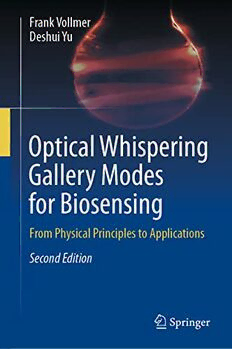Table Of ContentFrank Vollmer
Deshui Yu
Optical Whispering
Gallery Modes
for Biosensing
From Physical Principles to Applications
Second Edition
Optical Whispering Gallery Modes for Biosensing
·
Frank Vollmer Deshui Yu
Optical Whispering Gallery
Modes for Biosensing
From Physical Principles to Applications
Second Edition
FrankVollmer DeshuiYu
PhysicsandAstronomy PhysicsandAstronomy
UniversityofExeter UniversityofExeter
Exeter,UK Exeter,UK
ISBN 978-3-031-06857-7 ISBN 978-3-031-06858-4 (eBook)
https://doi.org/10.1007/978-3-031-06858-4
1stedition:©TheAuthor(s),underexclusivelicensetoSpringerNatureSwitzerlandAG2020
2ndedition:©TheEditor(s)(ifapplicable)andTheAuthor(s),underexclusivelicensetoSpringer
NatureSwitzerlandAG2022
Thisworkissubjecttocopyright.AllrightsaresolelyandexclusivelylicensedbythePublisher,whether
thewholeorpartofthematerialisconcerned,specificallytherightsoftranslation,reprinting,reuse
ofillustrations,recitation,broadcasting,reproductiononmicrofilmsorinanyotherphysicalway,and
transmissionorinformationstorageandretrieval,electronicadaptation,computersoftware,orbysimilar
ordissimilarmethodologynowknownorhereafterdeveloped.
Theuseofgeneraldescriptivenames,registerednames,trademarks,servicemarks,etc.inthispublication
doesnotimply,evenintheabsenceofaspecificstatement,thatsuchnamesareexemptfromtherelevant
protectivelawsandregulationsandthereforefreeforgeneraluse.
Thepublisher,theauthors,andtheeditorsaresafetoassumethattheadviceandinformationinthisbook
arebelievedtobetrueandaccurateatthedateofpublication.Neitherthepublishernortheauthorsor
theeditorsgiveawarranty,expressedorimplied,withrespecttothematerialcontainedhereinorforany
errorsoromissionsthatmayhavebeenmade.Thepublisherremainsneutralwithregardtojurisdictional
claimsinpublishedmapsandinstitutionalaffiliations.
Coverimage:SamirVartabiKashanian,Vollmerlaboratory,UniversityofExeter.
ThisSpringerimprintispublishedbytheregisteredcompanySpringerNatureSwitzerlandAG
Theregisteredcompanyaddressis:Gewerbestrasse11,6330Cham,Switzerland
Preface to the Second Edition
The second edition of our book titled Optical Whispering Gallery Modes for
Biosensing now includes extended discussions of advanced topics in microcavity
optics such as those on spectroscopy and sensing with optical frequency combs
(microcombs),opticalgyroscopes,andoptomechanicalmicrocavitydevices.Further
discussionshavebeenaddedonwhisperinggallerymodeatomtrapping,theparity–
time symmetry, and the lasing dynamics of macro- and microcavities, down to
the one-emitter (one-atom) laser. The book now includes an extended chapter on
single-molecule sensing including more details on the optoplasmonic whispering
gallery mode single-molecule sensors, an extended discussion of the detection of
protein conformational changes and enzyme activity, and a discussion of intracel-
lular(invivo)sensingandbarcodingapplicationsbasedonthewhisperinggallery
mode microlasers. Nearly 100 pages have been added to our manuscript that was
first published as part of the Springer Series on Biological and Medical Physics,
BiomedicalEngineeringinNovember2020.
Withacomprehensivediscussionofthefundamentalphysicsofopticalmicrocav-
itiesandtheinclusionofproblemsetsforeachofthesevenchapters,wehopethat
our second edition of Optical Whispering Gallery Modes for Biosensing not only
servesasaworkingreferencefortheactiveresearcher,butalsoprovidesascholarly
introductiontothefieldofopticalmicrocavitiesforuniversitystudentsandpostgrad-
uateresearchers.ThissecondeditionofourbookisastandaloneSpringertextbook
that, we believe, will be useful for both introductory and advanced courses about
themodernopticsofopticalmicrocavities.Wehopethattheinclusionofthebook
cover, which shows a wonderful image of the whispering gallery modes taken by
Dr.SamirVartabiKashanianinourlaboratoryattheUniversityofExeter,conveys
thebeautyandexcitementthatwe,theauthors,havealwaysfeltfortheresearchon
opticalmicrocavitiesandwhisperinggallerymodesundertakenbymanyexcellent
researchgroupsaroundtheglobeandwhich,insomanycases,isattheforefrontof
opticsandsensing.
v
vi PrefacetotheSecondEdition
In closing, we would like to thank the editors at Springer Nature, especially
Dr. Zachary Evenson for their continued and excellent support which made this
secondEditiontextbookareality.Thankyoutoo,MayumiNotoandDongjieWang.
Exeter,UK FrankVollmer
DeshuiYu
Preface to the First Edition
Theresearchonwhisperinggallerymode(WGM)biosensinghasalwaysbeenvery
exciting. It combines interesting physics with emerging applications in biophysics
and biology. The idea for writing a book about the physics of WGMs and their
applications in sensing and biosensing emerged around the year 2011. I started
teaching an interdisciplinary course on the physics of biosensing with WGMs. A
morecarefulreviewofthesubjectshowedthatsince2000,manyimportantadvances
inphysicsweremadewithWGMs.Thefieldofcavityoptomechanicshademerged;
nonlinear optical effects were studied with WGMs including multi-wave mixing,
parametericdown-conversion,andfrequencycombgeneration.Thedemonstration
ofstrongcouplingbetweenatomsandmoleculeswithWGMssparkedtheinterest
for using WGMs in cavity QED. A number of world-leading laboratories joined
the effort and made seminal contributions in the research area of optical micro-
cavities. The WGMs provide a particularly versatile experimentation platform for
those researchers to study the fundamentals of light–matter interactions, from the
classical to the quantum regimes. Many of the groundbreaking physics advances
weremadewithWGMs,andalmostalwaystheypointtoaninterestingapplication
in biosensing. Examples for this are the exceptional points and the quantum light
generatedorcollectedwithWGMsthatmightbeabletofurtherenhancedetection
sensitivitiesofsinglemolecules.AcomprehensivebookonWGMbiosensingwould
have to cover all of these exciting fundamental physics of WGMs. Book chapters
on the fundamental understanding of the sensing with light, the physics of WGM
inopticalmicrocavities,theapplicationofWGMmicrocavitiesinphysics,andthe
fundamentalsofquantumopticsandmolecularcavityQEDwouldbeneeded.
Tobeginwith,letalonecompletingsuchacomprehensivebookonthephysicsof
WGMsandtheirbiosensingapplicationsdidnotcomeabouteasily.Itrequiredthe
rightco-author.AfterImovedmylaboratorytoUniversityofExeter,UK,in2016,
the right co-author joined my group: Dr. Deshui Yu. Deshui is an exceptionally
talentedtheoristtrainedatPekingUniversity.DeshuijoinedmygroupatUniversity
ofExeterin2018toworkonthetheoryofWGMs.Deshuiwasveryexcitedwhen
Imentionedthebookprojecttohim.Althoughtheideaforthebookwasstillinits
veryearlystagesevenatthattime,Deshuiwasveryenthusiastictojointheproject.
vii
viii PrefacetotheFirstEdition
DeshuiisnotonlyoneofthefinesttheoristsImet,butalsoanexceptionallecturer
ofphysics.Deshuicanfindsimpleexplanationsforcomplicatedphysics.Heisable
to explain complicated physics without taking shortcuts. Effortlessly, he is able to
bridgetheoryandexperiment.Heengageswiththeresearchersfromotherfieldsand
disciplines.AlittlemorethanayearlaterafterDeshuijoined,thefirstdraftforour
bookwasready.IamdeeplyindebtedtoDeshuiforhishardworkandcommitment
tocompletingahigh-qualitybook.Deshui’simmensecontributionsresultedinthe
inclusionofadvancedtheoreticalchaptersthatareessentialforadeepunderstanding
oftheWGMphysics.Thebooknowfullyconveystheexcitementandappreciations
for this exciting research topic. The book covers most of the fundamental WGM
physicsandcombinesthemwiththechaptersonsensingwithlight,surfaceplasmon
resonance,andsinglemoleculesensing.Thebooktouchesnotonlyoncoresubjectsin
physics,butalsoonsomefundamentalaspectsofbiophysicsandchemistry.Itis,we
hope,aninspiringandcomprehensivereadforaninterdisciplinaryreadership.Iquote
Deshui:“Sciencewithouttheoryislame,theorywithoutexperimentationisblind”.
FrankVollmer
We hope this book will be a valuable resource for teaching the physics of optical
microcavities. We also hope for it to become a valuable resource for the active
users of WGMs, in their various applications including biosensing. The future for
WGM sensors is bright and just emerging. WGM sensors will help us to explore
the biophysics and biochemistry at the very limits of what humans are capable of
investigating. They are a platform to develop various nano- and quantum sensing
methodologies.TheycanallowustoexploreNature’ssmallestentitiessuchassingle
molecules,singlephotons,andfemto-Newtonforces,aswellasintricatemolecular
opticalpropertiessuchassingle-moleculechirality.Researchersmayfindthisbook
usefulfordevelopingnovelWGMsensingtechniques,suchasthosethatmayfurther
enablethedetectionandvisualizationofprocessesatthenanoscale,atultrahighsensi-
tivity,andinaspecificandsensitivemanner,downtothelevelofmolecules,atoms,
andbonds.TheauthorsbelievethatWGMsensorsandspectrometerswillhavemany
importantapplicationsinhealth,nanotechnology,metrology,environment,biology,
defense and security, and astronomy. We hope this book may aide in the develop-
ment of these next-generation biosensor applications, and that the book may help
extendtheseapplicationstoincludechip-scalesingle-moleculelaboratoriesforclin-
icaldiagnosticsthatprovidemaximuminformationbyanalyzingabiologicalsample
molecule-by-molecule.
Insummary,wewouldliketothankSequoiaAlbaWebsterandMithilParekhfor
contributingtotheveryearlystagesofthebookproject.Theauthorsthankallwho
have directly and indirectly contributed to the successful completion of the book.
Thankyoutoo,MayumiNotoandDongjieWang.
Exeter,UK FrankVollmer
DeshuiYu
Contents
1 SensingwithLight ............................................. 1
1.1 Introduction .............................................. 1
1.2 LightPropagationinSpace ................................. 2
1.2.1 VectorandScalarPotentials ........................ 4
1.2.2 WaveEquationsforElectricandMagneticFields ...... 7
1.2.3 BoundaryConditions .............................. 10
1.3 Polarizability ............................................. 12
1.3.1 ElectricDipole ................................... 12
1.3.2 LocalFieldCorrection ............................. 14
1.3.3 LorentzOscillatorModel .......................... 17
1.4 FrequencyandIntensityFluctuationsofLight ................. 21
1.4.1 AutocorrelationFunctionandSpectrum .............. 22
1.4.2 LorentzianandGaussianBroadening ................ 24
1.4.3 PhaseNoise ...................................... 27
1.4.4 HanburyBrown–TwissEffect ....................... 30
1.5 FrequencyStabilization .................................... 32
1.5.1 Fabry–PérotResonator ............................ 32
1.5.2 LC Oscillators ................................... 36
1.5.3 LaserFrequencyLockingtoTransmissionLine ....... 38
1.5.4 Pound–Drever–HallTechnique ..................... 39
1.5.5 ShotNoise ....................................... 43
1.5.6 OpticalHeterodyneandHomodyneDetection ........ 44
1.5.7 MeasuringthePhotonNumber ...................... 47
1.6 OpticalSensingTechnologies ............................... 48
1.6.1 Michelson–MorleyInterferometer ................... 48
1.6.2 OpticalClocks ................................... 49
1.6.3 SingleAtomDetection ............................ 51
1.6.4 OpticalTweezers ................................. 53
Problems ....................................................... 54
References ..................................................... 58
ix
x Contents
2 SurfacePlasmonResonance ..................................... 63
2.1 Introduction .............................................. 63
2.2 Plasmonics:InteractionofLightwithMetals .................. 64
2.2.1 Drude–SommerfeldModel ......................... 65
2.2.2 InterbandTransitionsofBoundElectrons ............ 66
2.2.3 Drude–LorentzModel ............................. 69
2.3 SurfacePlasmonPolaritons—SPPs .......................... 69
2.3.1 SPPsatPlaneInterfaces ........................... 70
2.3.2 ExcitationofSPPs ................................ 77
2.3.3 SPRSensors ..................................... 79
2.3.4 SurfacePlasmonOptics ............................ 80
2.4 LocalizedSurfacePlasmonResonances—LSPRs .............. 84
2.4.1 SphericalNanoparticles ............................ 85
2.4.2 EnergyStoredinMetalNanoparticles ................ 89
2.4.3 Nanoellipsoids ................................... 92
2.4.4 MieTheoryofLightScattering ..................... 93
2.4.5 NumericalMethodsforLSPRs ..................... 105
2.5 PlasmonicCouplingofNanoparticles ........................ 110
Problems ....................................................... 114
References ..................................................... 114
3 WhisperingGalleryModesinOpticalMicrocavities ............... 119
3.1 Introduction .............................................. 119
3.2 Microspheres ............................................. 120
3.2.1 StrictAnalyticalEigenmodes ....................... 121
3.2.2 AnalyticalWGMFrequencies ...................... 129
3.2.3 EffectiveModeVolume ............................ 132
3.2.4 ApproximateSolutions ............................ 134
3.2.5 IntrinsicQualityFactor ............................ 138
3.2.6 ExcitationofWGMs .............................. 142
3.3 Microbottles .............................................. 148
3.4 Microdisks ............................................... 153
3.5 Microtoroids .............................................. 158
3.6 Thermo-Refractive-Noise-LimitedFrequencyStability .......... 164
Problems ....................................................... 168
References ..................................................... 171
4 ApplicationsofWGMMicrocavitiesinPhysics .................... 175
4.1 Introduction .............................................. 175
4.2 LaserGeneration .......................................... 176
4.3 NonlinearFrequencyConversion ............................ 178
4.3.1 PockelsEffect .................................... 180
4.3.2 Multiple-WaveMixing ............................ 183
4.3.3 Second-OrderNonlinearity ......................... 184
4.3.4 FrequencyDoubling .............................. 187

